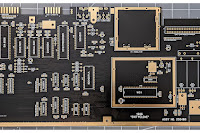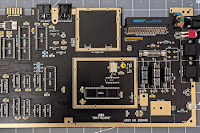
I recently had a bewildering moment. I was replacing the hard drive in my computer which meant removing the old one, inserting the new blank one, preparing it for the Operating System (OS) and then installing the new OS. It was one of those newfangled M.2 drives and after an unfeasibly complicated and infuriating process I finally got everything working and after re-installing all my software everything was back to normal. That was until I started to browse my photographs and noticed that everything from this year was missing. This seemed very odd as my photographs are stored on a different hard drive from the OS and I hadn't messed about with that drive. Never-the-less, they definitely weren't there.
Was I confused? Yes. Was I annoyed? Hell yes. Was I worried? Not at all. Why? Because (adopt a smug-as-hell demeanour) I have a damn good back up strategy so that if the worst happens, I can get everything back. As it happens, I can wipe that smug look off my face as I was being really stupid and my latest pictures had never been on that drive in the first place so... yes, not so smart after all.
Anyway, the point is that you should really have a way to recover your pictures in the event of disaster. Your hard drive will fail eventually; one day your computer will not boot and you need to have your precious data safe. What if the very worst happens and your house is burgled or burns down? Take a moment and think about these scenarios. If any one of them happened would you be able to get your pictures back? If the answer is No then you have a problem.
 |
| Hard drives fail. Is your data safe? |
So, let's look at my backup strategy and let's stress test it and see where the weaknesses are and in doing so perhaps it will give you some tips as to how you can improve yours?
There are two routines I employ depending on whether or not I will be returning home after a day of photography. We'll look at both of these then look at what I do when I do get home.
Day Trip Strategy
Risks: SD card Fails. Camera lost/stolen.
If it's a day trip and I know I'm returning home then the risks are minimised and I manage this simply by keeping spare SD cards with me (one on my person and one in the car). If the SD card I'm using fails then I can start using a spare immediately. It's possible that any pictures already on the failed SD card can be recovered with software. If the camera is lost or stolen then I've lost the lot and I just have to accept that I'm not getting that days pictures back and resign myself to calling the insurance company (your camera is insured right?)
Is there anything different I could do? Yes. I could use my mobile phone and regularly copy the pictures from my SD card to either the phone itself or a USB flash drive (or both) on the move. I could also look into Wifi enabled SD cards which would potentially make that process easier. Why don't I do this? I'm too busy having fun and for a day trip it's just not worth the hassle.
Vacation Strategy
Risks: SD card Fails. Camera lost/stolen. Hotel room burgled.
If I'm on holiday and I won't be returning home after day of photography I'm much more proactive. Again, I always have a couple of spare SD cards with me. If the SD card I'm using fails then I can start using a spare immediately and as above it's possible that any pictures already on the failed SD card can be recovered with software when I eventually get home.
Each evening when I'm back at the hotel I use an OTG Cable and a USB SD card reader to copy my pictures from the SD card to my mobile phone. Once they are on my mobile phone I copy them from my phone to a USB flash drive. This means my pictures are now in three places:
1: On the SD card.
2: On my mobile phone.
3: On a flash drive.
The flash drive stays in the hotel room (in the safe if it has one). This means if my camera is lost or stolen when I'm out then I only lose that day's pictures. If my phone is lost or stolen everything is still on the SD card and the USB drive. If the hotel room is broken into while I'm out (and they get into the safe) then I still have everything on the SD card in the camera and on my phone. If the hotel has a good WiFi connection and as I have a NAS (Network Attached Storage) at home which is internet connected I can log into it from my phone and copy JPEG versions of all my pictures to it which is fantastic for minimising the loss risks but this does take a long time and RAW files are too big (and usually too numerous) to transfer this way. This strategy has worked really well for me over the last few years and I've not lost a single picture yet (frantically touching wood).
When I Get Home
At home I have:
1. Computer
2. NAS
3. Two external hard drives
4. Cloud storage (with three separate providers)
When I return home I copy all my pictures from the SD card to my computer. Everything is then copied to my NAS which employs a mirrored array (two hard drives which are identical copies of each other). This is also copied to two external hard drives one of which is kept in a fireproof safebox. JPEG copies of pictures I want to keep are uploaded to three different cloud storage providers.
Let's look at the potential points of failure here and think about the risks of data loss:
My computer could break/virus etc.
All the pictures are still on the NAS and the external hard drives. When I upgraded the internal hard drive of my computer I kept the old drive (which still works fine) and I can swap this over in a few minutes if the internal hard drive is the point of failure.
The Drives in the NAS could fail.
If one drive fails the mirrored drive still has the data and this will be copied to a replacement drive I insert. All the pictures are still on my computer and on the external hard drives.
The NAS itself could break.
All the pictures are still on my computer and on the external hard drives.
External hard drives Fail
Still have everything on the NAS and on Computer. What are the chances of both external hard drives failing at the same time?
My house is burgled and the computer and NAS stolen.
Here I'm relying on the burglar not stealing one of my external hard drives. As one is locked in a fireproof box which is not in an obvious location I'm risking that a thief in a rush will be looking for high value belongings which they can carry away quickly and won't find it. In the event that everything is stolen I still have the JPEG copies of my best pictures in the cloud but all my RAW files will be gone. This could be mitigated by having a third external hard drive which I leave at another location but how often will I be able to get access to that to keep it up to date?
House Burns Down
This is obviously the worst case scenario but it can and does happen. My fireproof box is good for 30 minutes in a fire so there's a chance that might survive but in reality I'd have to accept that only the JPEGs in my cloud storage will survive. Again, this could be mitigated by having a third external hard drive which I leave at another location but how often will I be able to get access to that to keep it up to date?
Cloud Storage Provider Fails
Cloud storage isn't foolproof. Companies go bust or their own backup solutions fail and very occasionally data is lost. In the event this happens I've lost nothing as everything is still on my computer, NAS and external hard drives.
I forget to regularly backup
My backup process is principally manual and the biggest risk I face is forgetting to do it. For backing up to the external hard drives I use FreeFileSync, which ensures I have a mirrored copy of my files and which takes all the pain out of doing so, automatically comparing which files need to be backed up and making the copy for me. This makes it very easy, as long as I remember to run it regularly. Additionally, the NAS does automatically back up the last 12 months JPEGs to the cloud whilst JPEGs prior to that are already stored with two other providers where they'll be safe until such times as they aren't so I'm partially covered.
Conclusion
As I keep telling you, I'm not a pro and so my pictures aren't mission critical - they are not my career and I don't make money from them. That said, for a civilian I still have a competent backup routine which barring worst-case scenarios is pretty good for recovering files. My RAW files are clearly at risk in the event of theft or fire and there's a case to be made for burning my existing RAW files to an archival quality DVD and keeping these at another location so that if the worst happens I only lose the pictures that haven't made it to DVD. Not great but better than losing everything. Unfortunately at the moment I can't afford the cloud storage space to store all my RAW files - this would be the ideal solution and obviously I'll keep my eyes on this to see if prices fall in the future.
So, have I got myself covered? What would you do different?



